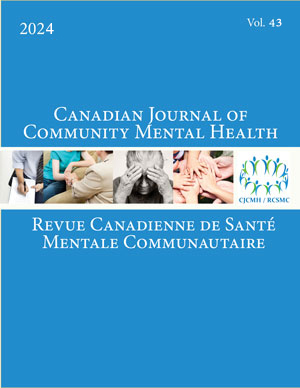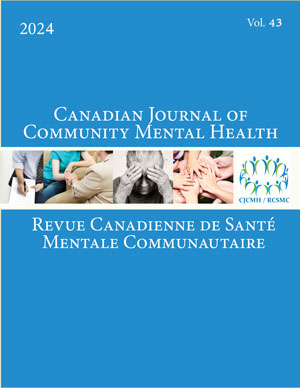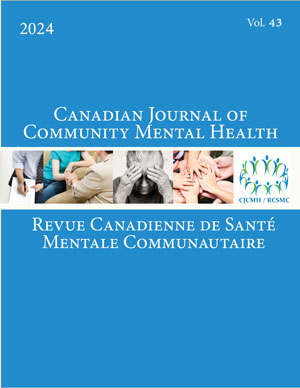Volume 36 • Number 2 • October 2017
Responses to the Mental Health Strategy for Canada: Canadian and International Perspectives on Mobilizing Change (Part 1)
Introduction
Articles
OPEN ACCESS
With 5 billion dollars in new federal funding to improve access to mental health services set to roll out over the next 10 years, a window of opportunity has opened to begin to close the long-standing gap in mental health funding in Canada. Public spending on mental health in Canada is only 7% of public spending on health overall (Jacobs et al., 2010), well short of the 9% called for in the Changing Directions, Changing Lives: The Mental Health Strategy for Canada (MHCC, 2012). This percentage is also well short of the disease burden comprised by mental illnesses, which ranges from 13% globally (WHO, 2011) to 23% in the UK (OECD, 2014). By comparison, recent figures from the Organisation for Economic Cooperation and Development (OECD, 2014) indicate that some countries devote as much as 18% of their health spending to mental health, with the UK sitting at 13%. Even with new targeted federal funding, closing, or at least narrowing, this gap will require careful attention to lessons learned in the past. This article explores how the gap in mental health funding came about in Canada and provides a more detailed analysis of the size of the gap itself. While it is now clear that the federal government will introduce a transfer that is directly targeted to mental health, there are still many policy options to consider for moving forward with next steps, including provincial/territorial contributions, accountability mechanisms, outcome measures, the insurance/financing model, and how tightly eligible expenses are tied to specific initiatives, population groups, or levels of evidence.
OPEN ACCESS
This case study explores how the Consensus Conference on the Mental Health of Emerging Adults, hosted by the Mental Health Commission of Canada in 2015, can impact mental health policy and practice in Canada. The study draws on interviews from 14 delegates who attended the conference. Participants praised innovations such as the inclusion of an emerging adult panel that provided feedback on all discussions, and efforts to make the consensus-building process meaningful in the Canadian policy context. Findings suggest that consensus conferences are a promising way to operationalize the Mental Health Strategy for Canada through policy and practice changes.
OPEN ACCESS
People experiencing mental illness and homelessness face numerous barriers to becoming housed. Service providers who work with this population also encounter challenges to meeting service users’ needs, yet their perspectives have been only minimally studied. Using survey data from a pan-Canadian study, this article explores the barriers and facilitators to fostering lasting change in housing and mental health according to 96 housing providers and 186 community-based mental health service providers. Findings show that the perspectives of mental health service providers are largely consistent with those of housing providers, and identify a range of support gaps and barriers.
OPEN ACCESS
The At Home / Chez Soi demonstration project was conducted to investigate the effectiveness of the Housing First model in 5 Canadian cities. Using a randomized controlled trial design, this study evaluates the impact of this project on the use of health services by people with severe and persistent mental health problems and a history of homelessness in the greater Moncton area. The sample comprised 193 homeless persons, 95 in the control group and 98 in the treatment group. The results show a significant difference between the 2 groups only in the number of days of hospitalization, particularly in the psychiatric unit. Factors associated with the use of health services by people who are homeless and who have severe mental health problems need to be further investigated.
OPEN ACCESS
With the inception of the mental health strategy for Canada, Changing Directions, Changing Lives, the ever increasing ethnic diversity in this country demands re-examination of our approaches to mental wellbeing and illness in the immigrant and refugee population arriving from war-torn countries. Contemporary clinical practice among mental health practitioners is not reflective of the emerging literature in this field, which points towards meaningful and culturally competent care. This article seeks to bridge the gap between existing knowledge and current practice, and provides recommendations for mental health practitioners who work with this population.
OPEN ACCESS
Youth engagement can improve the accessibility, effectiveness, and sustainability of programs and resources for youth. Little is known about youth engagement in system-level initiatives. As part of Systems Improvement through Service Collaboratives, an Ontario initiative that aimed to improve the system of care for youth with mental health or addictions needs, youth and adults in London, Ontario partnered to co-create Be Safe. The Be Safe resource helps youth manage mental health crises and identify local services. This article showcases a youth-adult partnership in a system-level initiative, and highlights a replicable strategy for developing resources relevant to youth needs and preferences.
OPEN ACCESS
This article describes a two-phase, multi-sectoral project aimed at enhancing youth services addressing substance use in Ontario. In the information gathering phase, a youth-focused website and survey, focus groups, and interviews were used to elicit perspectives from multiple stakeholders. In the implementation phase, capacity-building and consultations on transition-aged youth needs were conducted to inform youth transition-readiness checklists. We discuss the importance of engaging youth as collaborators as well as respondents and the processes used to tailor findings to local contexts for implementation.
OPEN ACCESS
We know much about the alarming trends in youth mental health; however, we know far less about the journeys that Canadian youth are taking toward better mental health. This article begins with a conceptual synthesis of the literature about the ways in which scholars are invoking the journeys of youth. We then present two examples of youth journeys in mental health from our current Atlantic Canada Children’s Effective Service Strategies in Mental Health project (ACCESS-MH) and conclude that journey approaches to youth mental health research could support the implementation of Canada’s mental health strategy in unique and crucial ways.
OPEN ACCESS
As child and youth mental health agencies apply the recommendations from the national mental health strategy, a strong focus has been placed on the implementation of evidence-informed practices to ensure the best outcomes for those they serve. Although a considerable amount of research exists on the implementation of best practices and the key factors to successful implementation, far less exists in terms of concrete strategies to support such initiatives. This article describes a unique initiative in Ontario that provided implementation supports and funding for agencies. Lessons learned and implications for bridging the gap between research and practice are explored.
OPEN ACCESS
The Caroline Families First Wraparound Program operationalizes cross-sectoral collaboration and planning, family peer support, and family-directed care consistent with strategic directions within the Mental Health Strategy for Canada. In this spotlight article, we present findings from a case study that describes what makes the program work, the barriers and facilitators to its success, and draw conclusions about the lessons learned. For example, while family-directed care is a core and essential value of the program, unless well understood, it can create tensions within teams. Similarly, structural factors such as provider reimbursement can inhibit physician involvement. Suggestions about these and other contextual factors can inform other efforts to mobilize the Mental Health Strategy.
OPEN ACCESS
Responsibility for suicide prevention falls to the Government of Canada and Health Canada. The issue of suicide affects Canadians of all ages and in all regions of the country, hence the need for a pan-Canadian strategy aimed at reducing suicide deaths and reaching all Canadians. The availability and accessibility of mental health services constitute important resources for suicide prevention and a target for interventions that can be made to rapidly reduce the suicide rate. Such a strategy to improve services should include quality surveillance and quality control programs, such as suicide audits and the use of linked government administrative databases. Population-based strategies to prevent and treat depression must also be established and should be based on the Nuremberg model. In particular, development of equitable access to psychotherapy and mental health literacy programs should be priority goals.










